By Bike Where East Meets West
This article first appeared in the August/September 2022 issue of Adventure Cyclist magazine.
The white van that had been slowly following us finally passed and then stopped, blocking our way forward. Two women in our 50s on a desolate road in rural Armenia, we braced ourselves, ready to jump off our bikes and use them as shields to defend ourselves if necessary. Two men in their late 20s exited the van and came straight toward us as we tensed. “Kopi? Cold kopi?” one asked as they proffered two cans of chilled and sweetened coffee! They had stopped just to offer us something to drink, a welcome gesture on a lonely road where we’d seen no human shelter or shop and few vehicles in more than two hours. After we expressed our heartfelt thanks, they drove away.
This kind gesture was one of many such acts of generosity we received in the three weeks that we toured almost the entire length and breadth of this small, landlocked country between Turkey and Azerbaijan, with Iran to the south and Georgia to the north. Jana had first read about Armenia in a 2005 travel article in our local newspaper that reported on Armenia’s ancient vank’ery, monasteries dating back to the Dark Ages. Jana immediately called her usual touring partner, Nikki.
“Let’s bike tour in Armenia!” Jana suggested.
“Great!” Nikki replied without hesitation. “Where’s Armenia?”
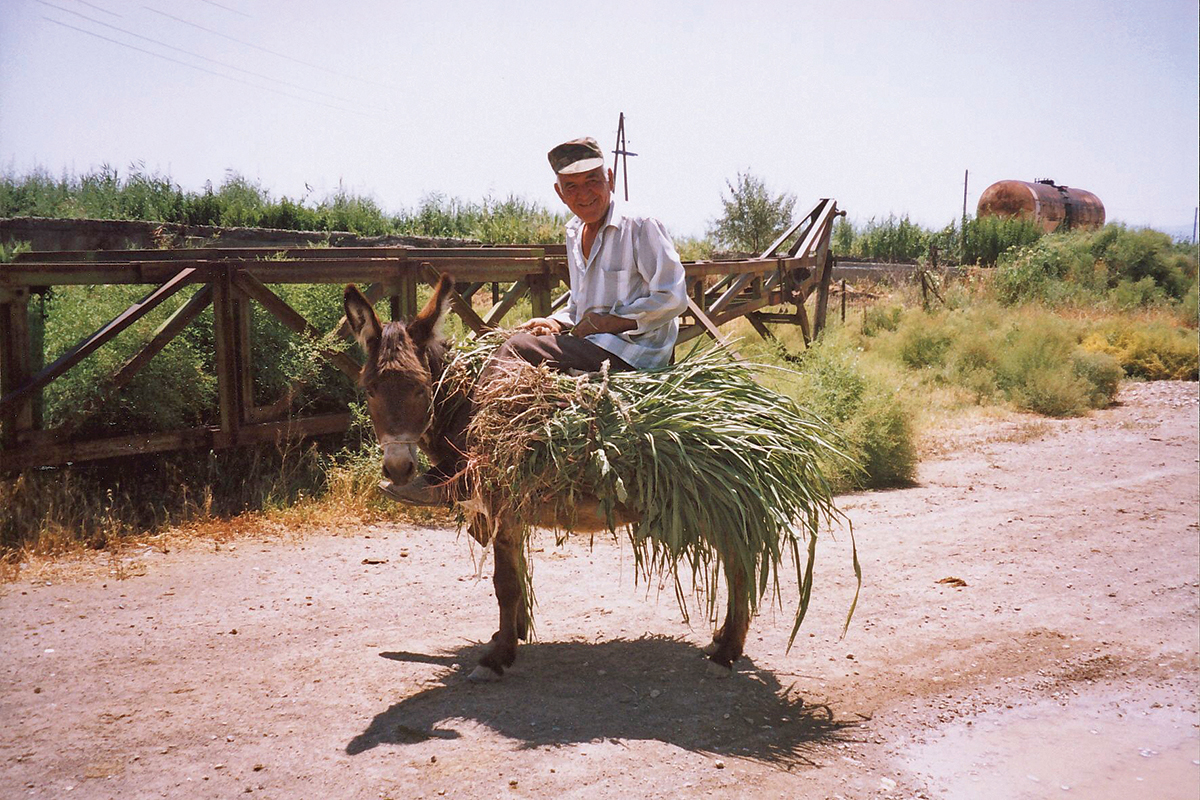
In the weeks that followed that first conversation in 2005, we started to learn more about this mysterious country far off the tourist radar. The more we learned, the more our adventure-seeking souls responded. Our local San Francisco art house cinema screened an Armenian movie called Lemon Vodka, largely to a small audience of Armenians who laughed uproariously at the absurd scenarios of pedestrians, horse carts, and old jalopy-style cars all stopping at the roadside vodka stand. Fortunately, the reality of Armenia was nothing at all like that silly comedy. We found copies of the Lonely Planet guide Georgia, Armenia, & Azerbaijan — its many photographs seducing us even more. Nikki placed an ad in Adventure Cyclist asking for help from anyone who could offer us information or assistance in planning our summer 2006 bike tour. Not more than a week after seeing that ad in the new issue, we were contacted by Komitas, an Armenian who provided lots of ideas about where to go and offered to meet us in the capital, Yerevan, to take us out cycling when we arrived.
A community college ESL colleague had family in Yerevan, and she offered to put us in contact with them. Another colleague connected us to a women’s activist group called Crabgrass, which was sponsoring a women’s shelter in Gyumri, a town in western Armenia devastated by the 6.8 magnitude 1998 earthquake, which killed 25,000 people and left much of it ruined. Thanks to the generosity of fellow ESL instructors and others, we collected over $3,000 to take to Helena, director of Ajakits (Helping Hands), the Armenian charity group running the shelter.
We took off in July 2006, a long flight from the U.S. to Germany to Vienna and finally to Yerevan. We mustered our last bit of energy to drag our panniers and bike boxes to the airport exit doors, where a young woman held a sign with our names! It was Miriam, the cousin of our Armenian-American colleague Armen. She and her brother grabbed our bike boxes and panniers, loaded everything and us into their sedan and, after a whirlwind half hour of conversation and blurring scenery, dropped us at Armenia’s one and only youth hostel, promising to call us to make plans for a meeting soon.
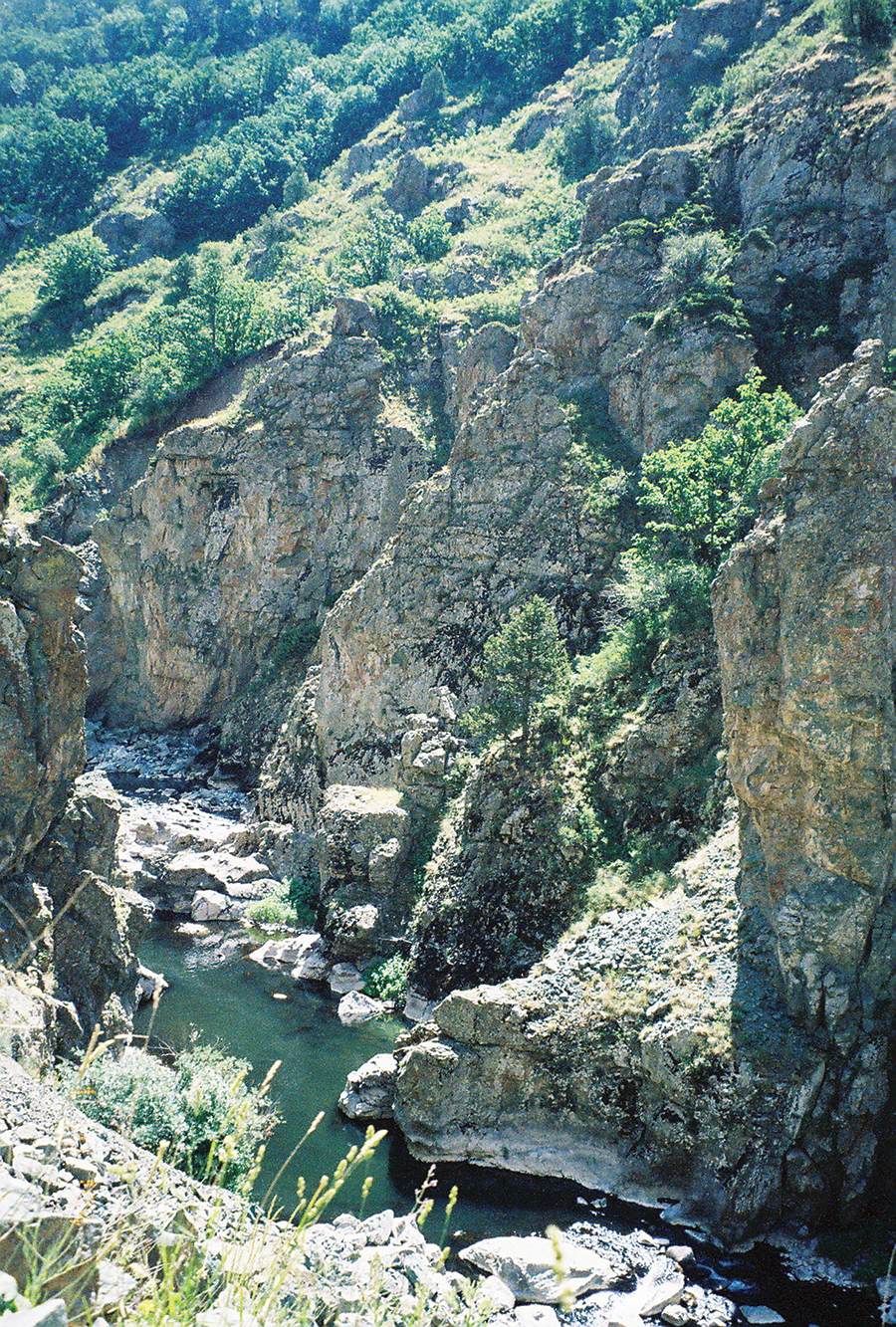
Envoy Hostel was a godsend for us: it had English-speaking staff who were patient and happy to help, comfy beds, and a good location in a quiet area of busy, stinky, loud Yerevan. At that time, almost everyone there spoke Russian as a second language, but since the Soviet Union crumbled in 1991, English had started to replace Russian as the foreign language to learn. We had both taken a Russian course for some basics and had an Armenian phrase book (and were both good at charades), but getting to speak in our fluent language amid the chaos of an unfamiliar country was a grounding comfort. After barely time to wash our faces, we had to run off to meet Helena, the woman to whom we were passing the $3,200 that Jana had been carrying in a money belt. We were desperate to get that money off us and passed on to her. We met her at a hotel where she was attending a conference, and after the pass-off we felt much lighter and freer. With promises to visit her in Gyumri, we went back to the hostel to crash.
Over the next few days, we faced certain death crossing Yerevan’s wide boulevards in chaotic traffic. However, when we cycled with Komitas into the countryside, we found the main road much less busy. We scored addresses from all around Armenia from Peace Corps volunteers who came to Yerevan for a training course and were housed at our hostel. (And we gratefully used a couple of them later on our trip in parts of the country with no tourist lodging.) We met up again with Miriam and her sister Lilit for guided tours around Yerevan’s sites and had a lovely dinner of typical Armenian cuisine at their home prepared by their mother Gohar. With promises to meet again at the end of our three weeks, we left their home with the knowledge that our real trip would start the following day.
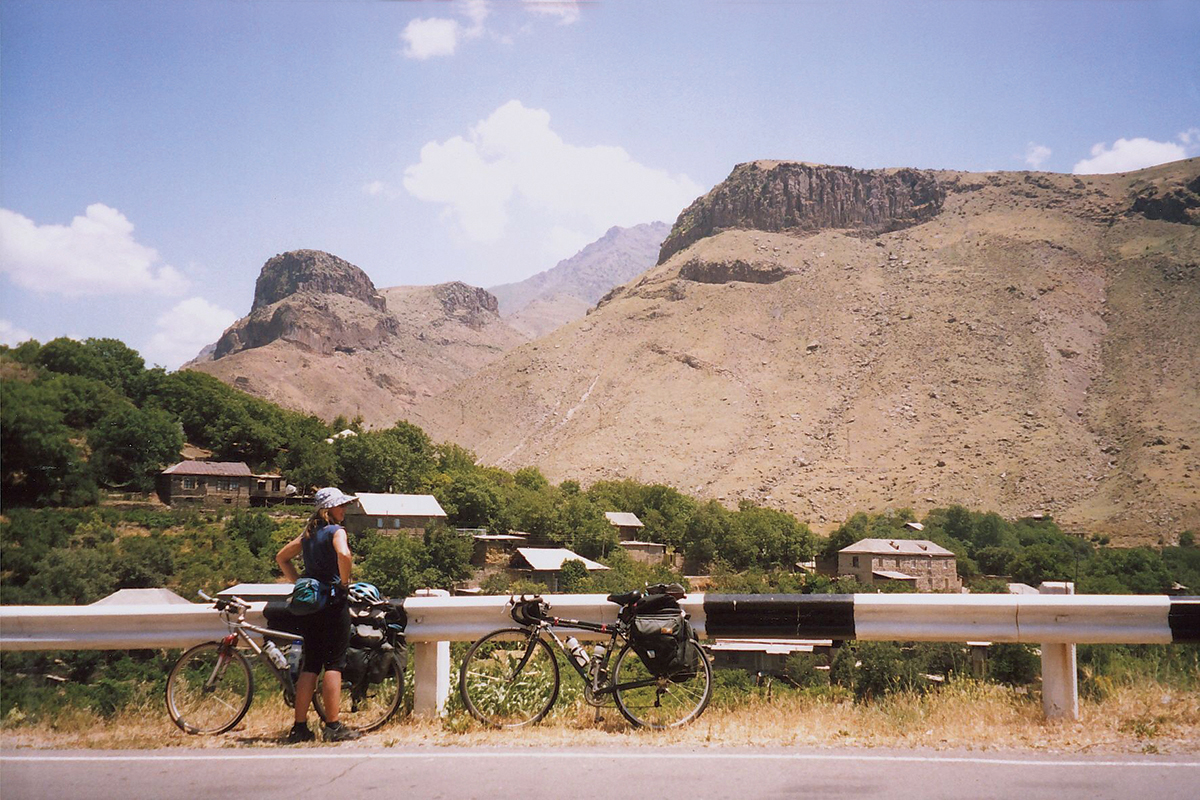
Our first day out started very early so that we could avoid the worst of Yerevan’s snarled and crazy traffic. No more than two hours out, we were passed by a group of cyclists whose shirts announced them as Armenia’s national cycling team! It was reassuring to see fellow cyclists on the road. Little did we know that except for one or two broken-down bicycles, those were the only bicycles and cyclists we would see in our entire three weeks. We were pleasantly surprised by the good road surface, which we found out later was a gift to Armenia from Kirk Kerkorian, a Las Vegas casino tycoon of Armenian descent. And we were startled by the loud and crazy car and truck horns that sometimes sounded like sirens and at other times resembled a circus clown’s awooga.
Later, the afternoon heat found us pedaling halfway up Armenia’s highest mountain, Mount Aragats, to Byurakan, a stone village with a guesthouse near Armenia’s only observatory. After checking into the simple but comfy Pine Tree House (trees were rare in most places, but Byurakan was green), we accepted the owners’ invitation to a simple but filling dinner in their kitchen, followed by a guided visit of the observatory. While the observatory itself was not that impressive, the owners’ warm welcome made us comfortable, and the scenery and cycling in the mountains was a great improvement from our previous hours riding on the plains — which proved true for our entire trip.
After the typical breakfast of bread, fruit, jam, yogurt, cheese, and coffee the next morning, we were game to continue riding along Aragat’s shoulder to Talin and then on to Gyumri, where Helena hosted us. We took a drive to the countryside for a picnic and took a tour of the city. We spent two full days in Gyumri, visiting the shelter and meeting a few women there who had been abused by their husbands or partners. One had visible scars from cigarette burns all over her arms.
The next morning, we pushed on to the next mountain pass, where we visited a cemetery with life-sized etchings of the deceased atop every tomb. This mountain pass offered trees and cooler air, with little traffic, lovely scenery, and negligible pollution. At the summit, we almost didn’t want to descend into the next hot, smoggy valley. Although the large town in the valley, leafy Vanadzor, was more pleasant, it still lacked the charm or interest to make us linger, so at the road intersection, we turned north for some hours to reach one of Armenia’s most famous monasteries, Haghpat. Armenia, despite being surrounded by Muslim countries, is the world’s oldest Christian country, having converted in A.D. 301.
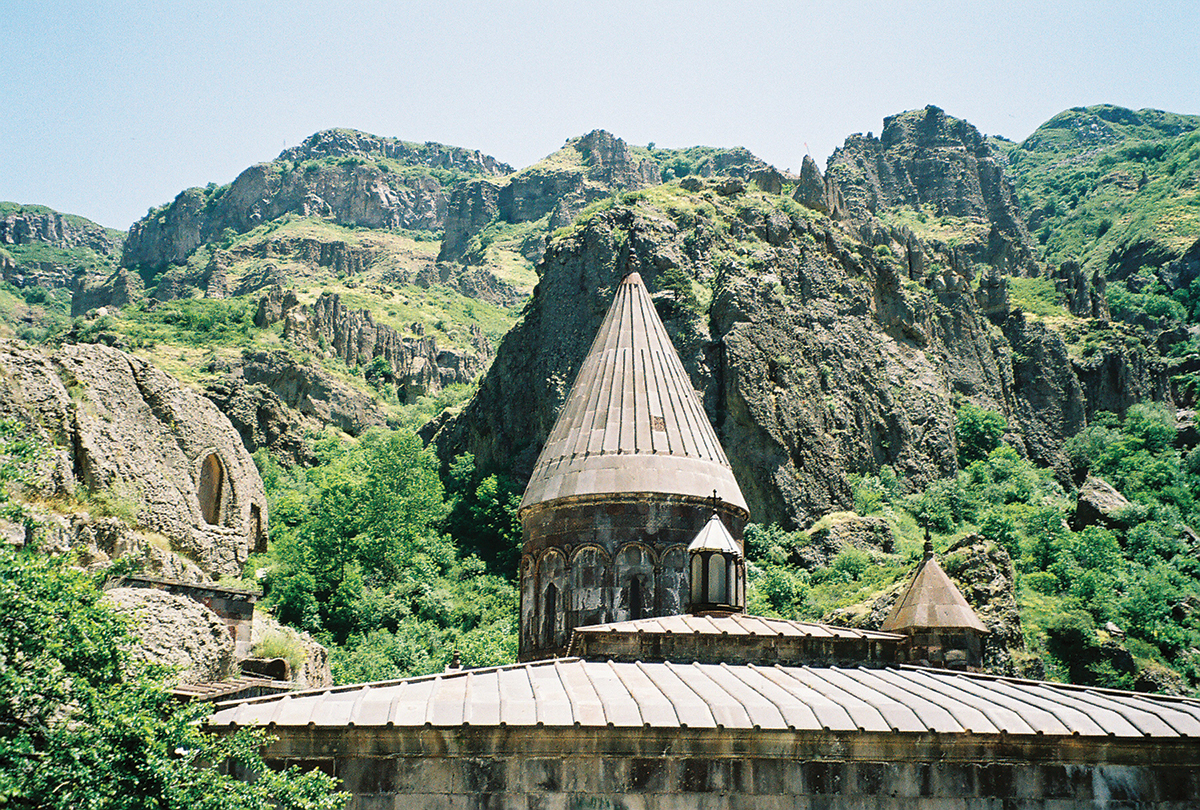
Leaving the main road at Alaverdi, we pedaled up a long, steep hill to the lip of Debed Canyon in order to reach the Haghpat Monastery, a UNESCO World Heritage Site. But before exploring the monastery, we were hoping to secure a room for the night in the tiny village’s only guesthouse listed in our Lonely Planet. We asked a few people as we pedaled our way up through the village, but no one seemed to know where it was. When we got to the main square, a woman asked us what we were looking for, and after mentioning the guesthouse, a crowd of village women gathered to gawk at the two foreign women cyclists — but then, after gazing their fill, they snapped into action, whipping out their phones to look it up for us, only to inform us that the guesthouse was no longer in operation. Where could we stay? We didn’t want to ride all the way back down the mountain and stay in the hot and unpleasant town below; plus, we needed time to explore the vank (monastery). Finally, an elderly woman who looked to be the oldest in the group motioned to us, indicating that we could stay with her. Younger people were more likely to speak Russian than older folks, so our common language was gestures and goodwill. We followed her to a long, narrow flight of stone steps — ones that would have been a challenge to carry even unloaded bikes down. Those steep steps plus the uncertainty of the accommodations left us wary. Smiling and thanking her, we decided to hope for the best as we continued pedaling our bikes to the top of the village and the entrance of the monastery, where to our pleasant surprise, we found a simple snack bar.
We were eating and contemplating our options when a woman came out of the house facing the vank and said, “Hotel?” Of course, we excitedly replied “Yes, please!” which led to one of our most interesting stays of the entire trip. Anoush was a large, affectionate woman who immediately took us under her wing. The house lacked indoor plumbing, but she heated up a large pot of water, poured it into a plastic tub, and helped each of us bathe and wash our hair as if we were her two young daughters. She then showed us the “facilities,” which consisted of a ramshackle wooden outhouse suspended by narrow wooden planks out over the lovely rose garden. If we slipped, we would either end up squashing the roses or falling into the cesspool under the outhouse. While manageable in the daytime, navigating the wooden planks at night with a headlamp would have been treacherous at best. One false step and we’d probably never be seen again. We decided that there was no way we were going to risk such a fate that night and instead equipped ourselves with containers to handle any nighttime calls of nature.
Later, we ate dinner with Anoush and her husband, who spoke some English. Like most of our meals, the same offerings showed up at their dinner table: a big, fresh salad with delicious cucumbers and tomatoes, a strong sheep cheese, a sturdy loaf of bread and some yogurt, and rice with a little meat, this time chicken. During this simple but filling meal, Anoush’s husband regaled us with tales from their visit to the U.S. five years earlier. We fell into bed tired but happy that we had a roof over our heads — and no stairs to face. Better yet, our improvised chamber pots saved us from having to “walk the plank!”
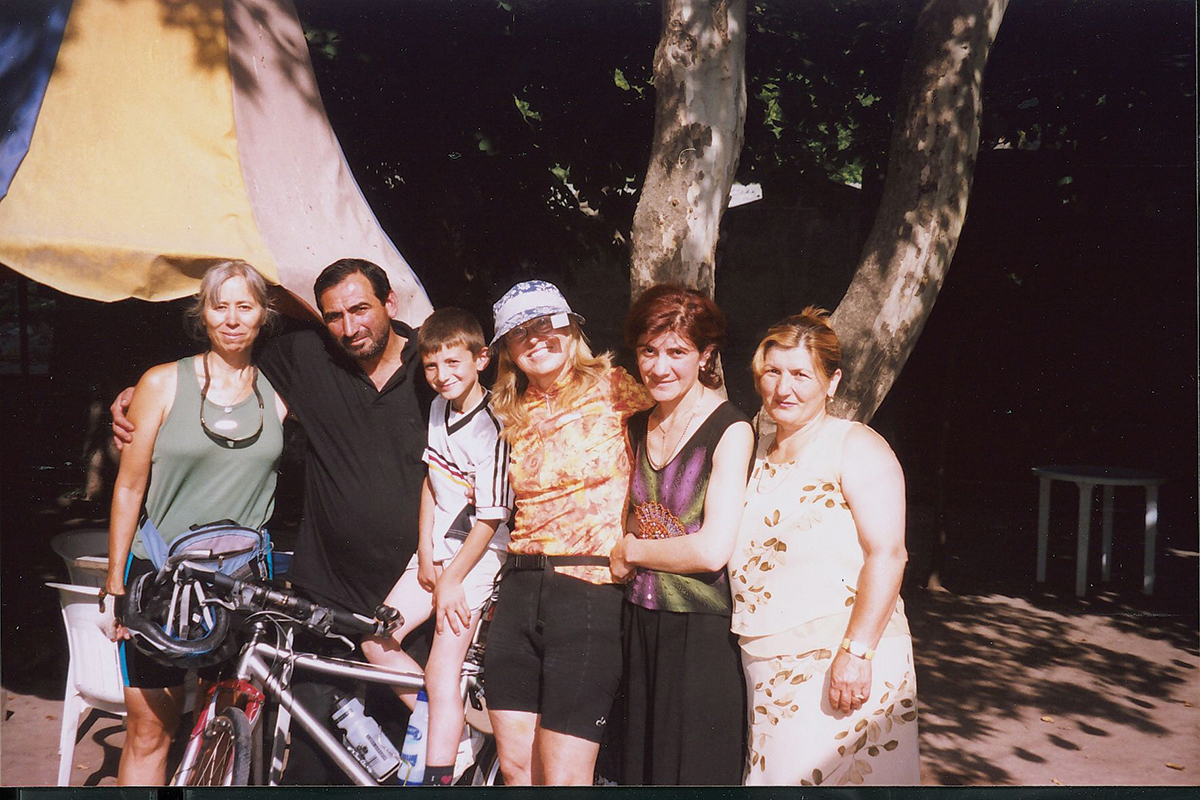
The next week offered pleasant riding in the northern mountains and around the border of Azerbaijan to Lake Sevan — a large mountain lake in the east. After a full day of cycling within sight of the lakeshore, we arrived in an unmemorable area of Armenia, but even in the next four days there, there were unexpected surprises. A number of marshrutkas (public buses) passed us daily, with the entire busload of passengers craning their necks to stare at us until the bus was far away. We seemed to offer the same fascination as rock stars or Martians.
A less pleasant surprise was our more frequent encounters with roadside dogs during this second half of our trip. This occupational hazard for most cycle tourists was particularly anxiety-producing due to the dogs’ unpredictable behavior. Most dogs were not chained up and many would take off after us, snarling and barking, with no owners in sight to restrain them or call them back. We soon developed a strategy for fending off these canine attacks: we found some lengths of rubber hose along the road and carried them with us; if a dog pursued us, we would strike at it with the hose while at the same time yelling, “Che! Che!” which is “No!” in Armenian. This was usually an effective deterrent to get them off our wheels, and we managed to complete the entire tour bite-free.
Reaching southern Armenia, we got to cycle on more pleasant, albeit long, mountain passes again, and in the roadside villages, women motioned us to stop and rest and offered us tea and/or a snack. Most Armenians were poor, but one would never know it from their open-hearted generosity and hospitality. We would have covered much less ground in Armenia if we had accepted all the offers of refreshments. At the top of one such mountain pass, we stopped at a highlight of our trip: the Selim caravanserai, an inn built in 1332 for traders and their pack animals on the Silk Road (which we were riding on at the time as we pedaled through the region of Vayots Dzor). Our Lonely Planet guide explained that the lintel, looking appropriately exotic, held an inscription that identified it as a gift of the Orbelian princes almost eight centuries earlier. Inside its dark basalt walls were two rooms for the Silk Road travelers to rest. While our imaginations went crazy picturing the caravans that had rested in those very walls, we ourselves rested only briefly, as the long climb up to Jermuk called to us.
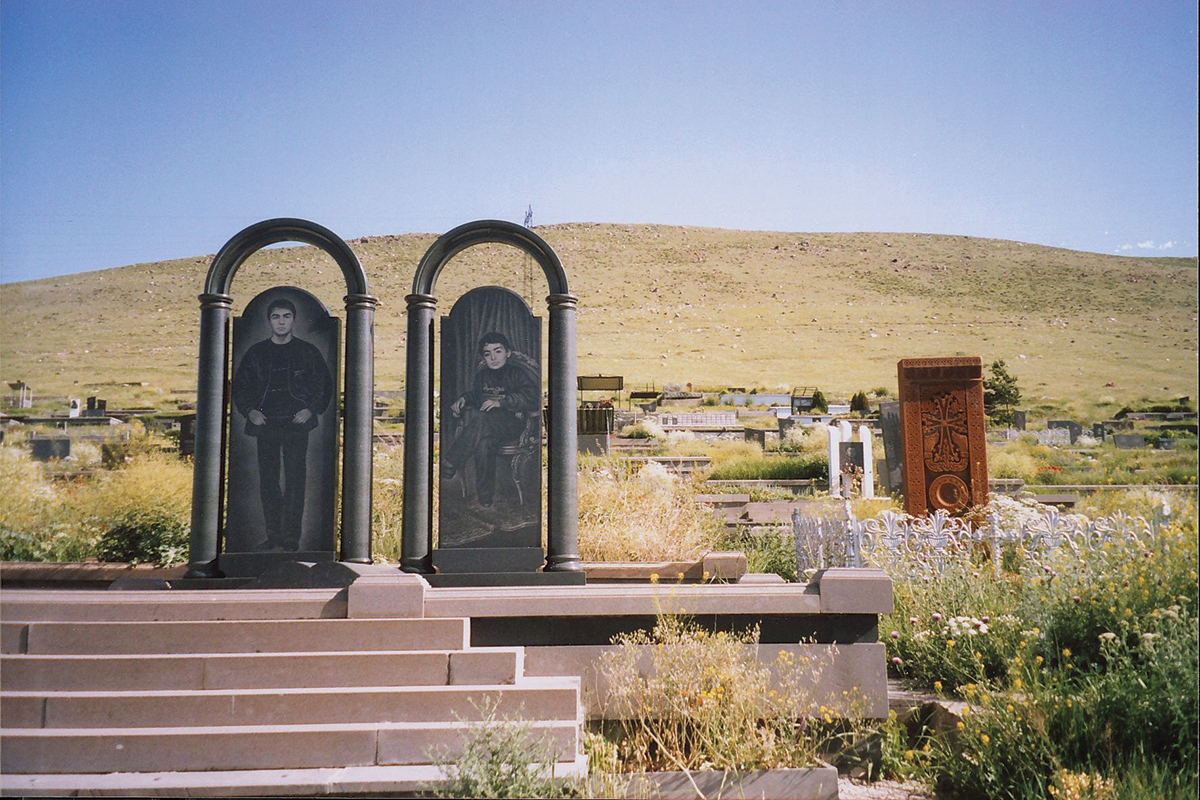
The extended ascent to the spa resort town of Jermuk in the mountains above the Arpa River was well worth the effort, not just to reach this oasis but more for our memorable experiences with the locals. We stayed at the Vayots Dzor Hotel, a modest establishment where we seemed to be the only guests. The manager, Ignats, and his staff did everything they could to make sure we had the most enjoyable stay possible. Gamlet, one of the employees, took it upon himself to show us around Jermuk. This included a wonderful walk through the gardens bordering the Arpa River canyon and tasting the mineral-rich waters from a special public water fountain. Gamlet left us then so that we could have a post-Soviet spa experience. Unfortunately, Jermuk’s glory days as a spa getaway seemed to have faded with the dissolution of the Soviet Union, but we finally found one that was open. We paid our entry fee with no clear idea what we were paying for, and here again, we seemed to be the only clients. We were first led into a room full of bathtubs, and we each climbed into our own individual tub filled with hot mineral water. After what seemed much too short a time, the attendant motioned us to get out and then rushed us through a hallway, naked and without towels, to our massages. We were then perfunctorily roughed up by a masseuse with one of the least pleasant, but fortunately shortest, massages of our lives.
Given that less-than-satisfactory spa adventure, we were delighted when we returned for our last night at the hotel, where the staff had prepared a traditional khorovats, or barbecue, consisting of various grilled meats, along with other local dishes. They refused to accept payment for this surprise meal, making it an even more special treat.
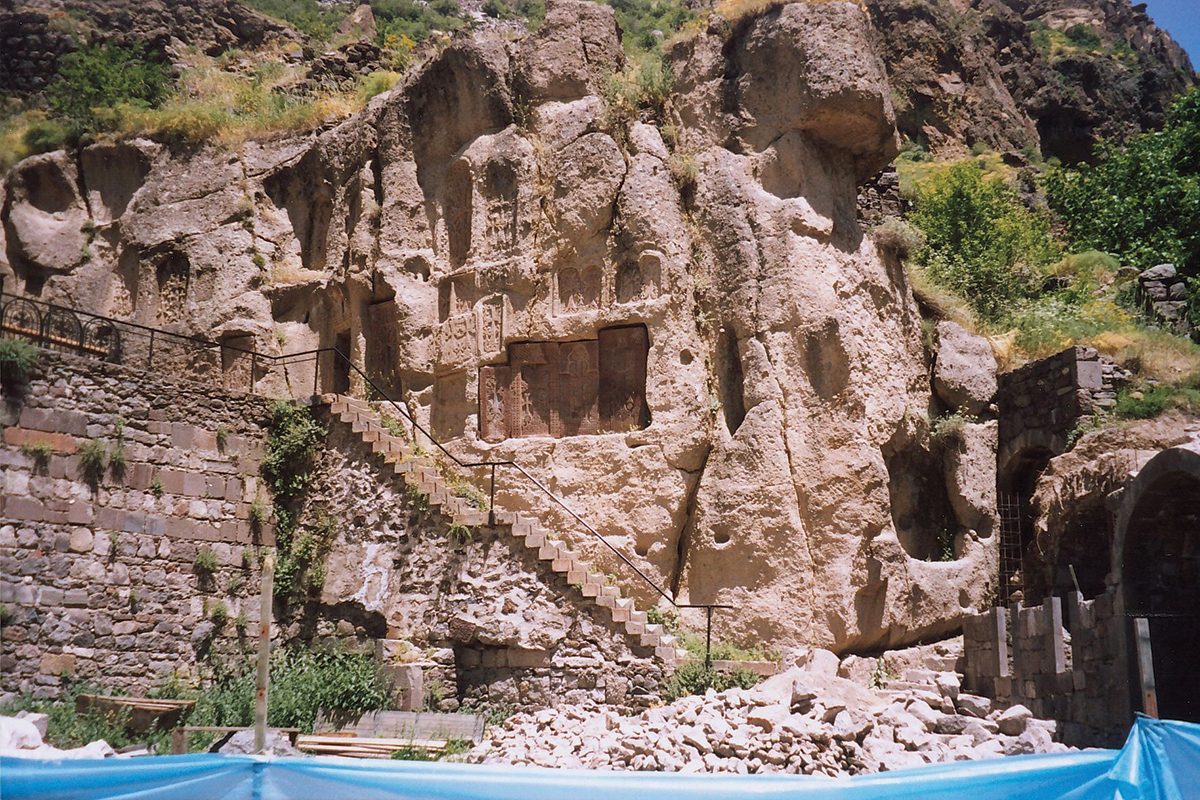
Almost as lovely as staying in Jermuk was leaving it, via a pretty, 20-kilometer descent to the intersection of the main road toward Iran at Vayk. As we pedaled east and slowly up one of Armenia’s highest passes, Vorotan Pass (2,344 meters), truck after truck with Iranian plates passed us. (As a landlocked country, Armenia depends on trucking from Georgia to the north and Iran to the south for much of its imported goods.) During a rest at the summit, a number of Iranian truck drivers greeted us, some of whom spoke English well enough to allow for a basic conversation. When we touched on the thorny topic of politics, the Iranians were quick to dismiss the hostility between then-President Bush and Khomeini as animosity only among the leaders, whereas they liked and admired Americans. We assured them that we felt the same. Just as we were leaving, a young teenager came down from the mountain above us with a bouquet of flowers that he held out, greeting us in English and explaining that he was a Kurd who lived up in those mountains. He had been collecting the flowers for his mother, but after we met, he decided to offer them to us instead!
Not long after descending the pass, we arrived at a final favorite stay of ours, Goris, where we spent two nights. Cool and leafy Goris perches on the edge of a deep valley, and across the gulf are the caves and stables of “Old Goris,” some dating back to the fifth century. Khachik Mirakyan B&B was a very pleasant, comfortable guesthouse with a large balcony for lounging and admiring the view across the new town to the old caves. Our welcoming host, Khachik, saw to our meals, bikes, bathing options, and traveler needs with warmth and humor. After a bath and a tasty dinner, we sampled Khachik’s “moonshine:” mulberry oghi (brandy) and then took a tour of his mulberry and other fruit trees.
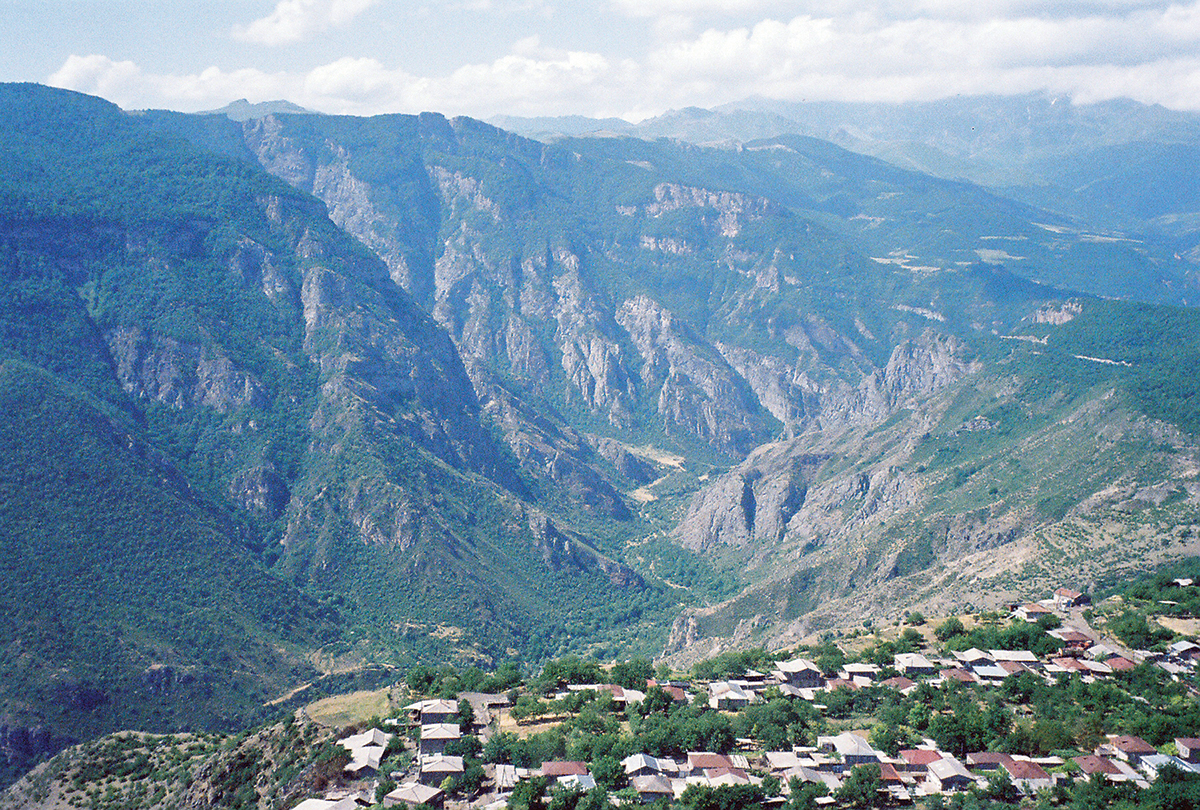
The next day, before leaving this southernmost point of our journey and heading back to Yerevan, we wanted to visit Tatev, a ninth-century monastery built on the edge of the Vorotan Canyon. While it is only 28 kilometers from the town of Goris, in order to get there we had to descend steeply to the bottom of the canyon and then climb up the other side, all on a poorly maintained dirt road that even a four-wheel-drive vehicle would have had difficulty negotiating. Luckily, this was just a day ride, so our bikes weren’t loaded, but that didn’t mean it was easy! Jana was on a mountain bike, but Nikki was on her touring bike with drop handlebars and touring tires, so it was particularly challenging. After picking our way to the bottom over the bone-rattling road surface, we were faced with an even more daunting uphill, and it seemed like an entire day before we finally reached the top. In a daze, we toured the lovely monastery grounds and its ancient stone interior. We marveled that the monks had been able to build this huge stone structure so far from materials and roads. We were even more surprised to learn that almost 900 monks had lived in this isolated spot during the monastery’s heyday. Coming out into the streaming late afternoon sun, we decided that there was no way we were going to retrace our steps down and back up the canyon to return to Goris, so we looked around for alternative transportation. Not seeing anything that looked like a taxi, Nikki went up to a local man standing near the monastery and inquired, “Taxi?” Luckily, since this word is virtually universal, he immediately summoned a friend with a car, albeit one much too small for carrying two bikes and two passengers. No problem! He took out the back seats, crammed us and our bikes inside, and drove us back to Goris for the equivalent of about 10 dollars — the best money we’d ever spent!
Back in Goris that evening, we recounted our adventure to Khachik, who advised us to take another taxi to get most of the way back to Yerevan, as our days left were numbered. At lunch the next day at the wine capital of Areni, we were tempted to order a bottle of the recommended red to go with our celebratory meal, but later, when we found that we were still going to have to cycle about 35 miles that afternoon to get back to Yerevan, we were glad to have held the line with a glass each.
Nuts & Bolts
Armenia
Getting There
There are currently no nonstop flights from either coast to Yerevan; a one-stop flight will be pricier, with options from the Star Alliance network (United or Lufthansa and Austrian or Qatar Air). Two-stop flights are more plentiful and cheaper.
Flights to Armenia arrive in Zvartnots airport, 12 kilometers from Yerevan. The Airport Express mini-bus makes the trip to the city center in 30–45 minutes for about 300 AMD (about 75 cents). A taxi is generally about 5,000 AMD for a 20-minute ride. Currently 1,000 AMD is about $2.00.
When to Go
Mild temperatures and wildflowers make spring a good time to visit, while autumn offers more stable weather and less rain. Summer is very hot in the south, with summer temps in Yerevan topping 100°F for days at a time. Winter is quite cold and not recommended.
Where to Stay and Eat
Many options exist in Armenia now, from nicer hotels (Marriott, Holiday Inn) to smaller hotels, guesthouses, Airbnbs and hostels. Envoy Hostel ($12/night and up), where we stayed, is still highly recommended, as are Yellow Fox and Kantar hostels, roughly in the same price range.
Restaurants abound in Yerevan, where a variety of cuisine types and choices are offered. In smaller towns, the choices are more limited, but the food is generally healthy and tasty, and often by default organic. Vegetarians and vegans will have little problem tailoring their meals to fit their diets. For meat eaters, restaurants offering khoravats (barbecue) are widespread and recommended. Also, according to a 2019 Forbes magazine article, Armenian wine is good and improving year by year, but we were generally served sweet red wines, so ask before ordering.
For travel farther afield, use of an updated travel guide is highly recommended. Lonely Planet just published the 2022 Guide to Georgia, Armenia, and Azerbaijan. Two other popular guides seem to be Armenia Bradt Travel Guide (2019) and Armenia Travel Guide (2020) by Maria Asatryan.
The website wildarmenia.com offers a complete guide to camping in Armenia.
Bike Routes and Rentals/Repairs
Internet searches now show bike stores and repair shops in Yerevan. A great site offering lots of good routes in Armenia is cyclingarmenia.com. Another good site for identifying bike routes and also for renting a bike in Armenia is araratour.com. Outside of Yerevan, rentals and repairs decrease considerably.
Getting Around When not Cycling
Marshrutkas (minivans) are the main public transport and very reasonable. Enterprise, Europcar, and Hertz rent cars at Zvartnots airport, and taxis can be a good way to transport bikes for sketchy or uninteresting stretches.
Communicating
When we were bike touring in 2006, English was not generally spoken, so our basic Russian was quite helpful. Today many Armenians have a basic command of English, especially younger people, so touring is possible using only English (with occasional charades).
Visiting Tatev
Riding the challenging route to Tatev was a highlight of our trip in Armenia, as it demanded both strength and excellent bike handling, as well as leading us to an amazing ninth-century building in a unique location. Today visitors may take the world’s longest aerial tramway, Wings of Tatev, to make the crossing of the deep Voratan River Gorge to Tatev.

